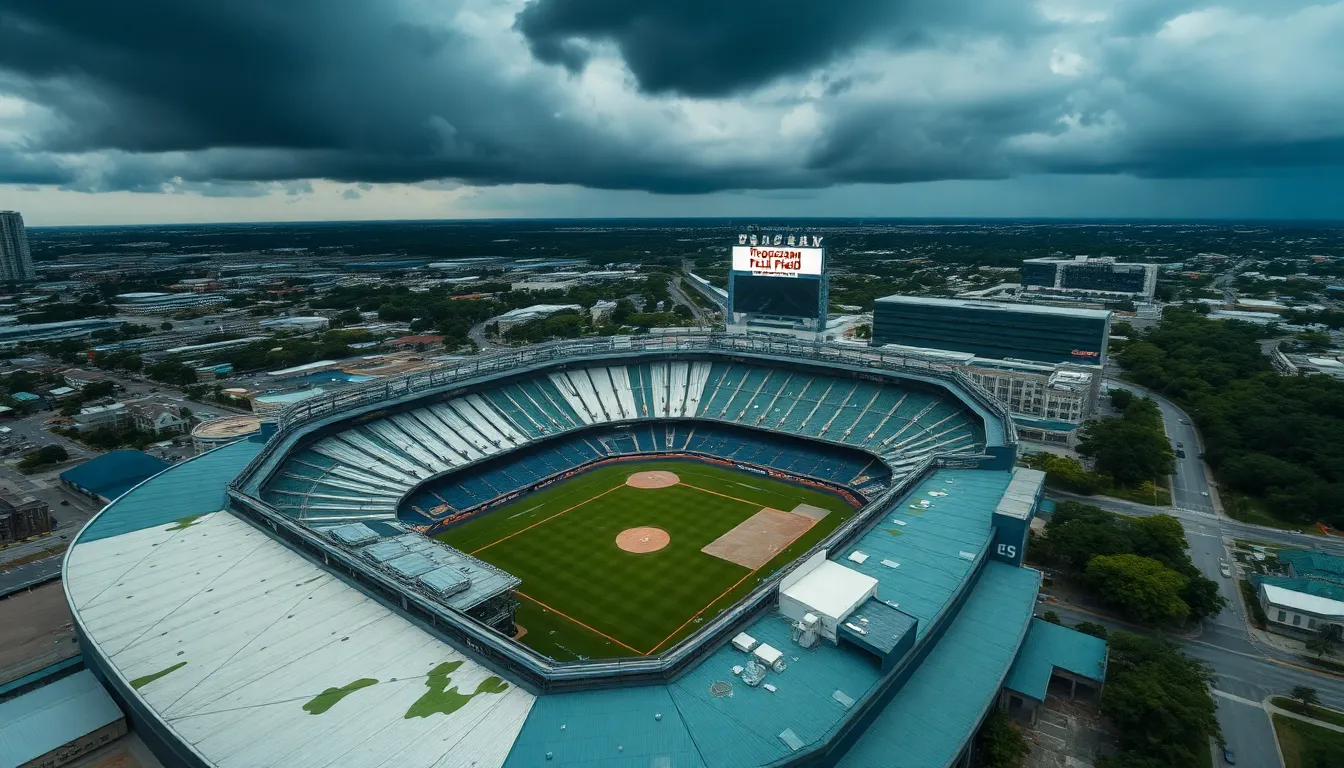Table of Contents
ToggleTampa Bay is known for its sunny skies and vibrant sports culture, but lately, the Rays’ stadium has taken a hit—and not just from a home run. Fans are scratching their heads and wondering if the roof is about to join the ranks of the team’s former players in retirement. With unexpected damage causing quite the stir, it’s time to dive into the saga of the stadium that’s seen better days.
Overview of Tampa Bay Rays Stadium
Tropicana Field serves as the home for the Tampa Bay Rays, located in St. Petersburg, Florida. This stadium has undergone various renovations since its opening in 1990, aiming to enhance fan experience and improve facilities. Despite these efforts, recent damage has surfaced, prompting concerns about its structural integrity.
Major leaks appeared in multiple areas of the stadium, particularly affecting the seating sections and concourses. Maintenance personnel discovered these leaks during routine inspections, raising alarms about potential safety hazards. In addition, water damage has led to visible deterioration in certain areas, including mold growth and weakened structures.
Capacity remains at approximately 25,000 for baseball games, but these maintenance issues could impact attendance and overall game-day atmosphere. The management team acknowledges the need for urgent repairs to restore the venue’s reputation and ensure fan safety. Financial constraints complicate the situation, as extensive renovations typically require significant investment.
External factors, such as extreme weather events, may exacerbate the existing issues. High winds and heavy rain pose risks not only to the stadium’s physical structures but also to the electrical systems and overall operations. Strategies to mitigate damage from these events are essential moving forward.
Improvement plans are currently being discussed among the stadium’s management, fan representatives, and city officials. Engaging the community is crucial for gathering support and ensuring necessary funding for repairs. By addressing these issues proactively, the Tampa Bay Rays aim to maintain a secure and enjoyable environment for their fans.
Recent Events Leading to Stadium Damage

Recent weather patterns have significantly affected Tropicana Field, increasing concerns over the stadium’s structure. Heavy rainfall and strong winds have caused major leaks within the facility. As a result, water damage has impacted critical areas, leading to further deterioration. The ongoing threat posed by severe storms places additional strain on the stadium’s existing infrastructure.
Impact of Weather Conditions
Weather conditions contribute greatly to the current state of the stadium. Flooding from intense storms exacerbates existing vulnerabilities in the building. These conditions disrupt operations, especially during the wet season, leading to canceled events and reduced attendance. Understanding this relationship is essential for developing a comprehensive repair plan. Management recognizes that addressing weather-related issues requires immediate action to ensure safety and comfort for fans.
Construction Concerns
Construction quality also affects the ongoing issues at the stadium. Aging materials from the original build have not held up well against time and climate. Poor drainage systems have intensified water accumulation, further compromising structural integrity. Recent inspections highlighted several critical faults that require intervention. Stakeholders emphasize that renovations must include materials designed for longevity to prevent future damage. Engaging experts in stadium maintenance remains crucial for restoring safety and enhancing fan experience.
Types of Damage Experienced
Tropicana Field has faced various types of damage that threaten its operational efficiency and safety. Specific issues have emerged across the stadium, highlighting the need for urgent repairs.
Structural Issues
Significant structural concerns have surfaced, primarily due to aging materials. Water damage from persistent leaks has compromised beams and walls, raising questions about the overall integrity of the facility. Inspections have confirmed that poor drainage exacerbates these issues, with chronic flooding leading to accelerated wear. An urgent focus on restoring structural components is crucial, as these fundamental flaws pose risks to player safety and fan comfort.
Surface and Field Damage
Field conditions have deteriorated due to excessive moisture and inadequate maintenance. Water pooling on the turf creates an uneven playing surface, affecting gameplay and increasing injury risks for players. The grass has shown signs of decay, mainly attributed to repeated exposure to wet conditions. These surface issues not only diminish the aesthetic appeal of the stadium but also impact the fan experience during games. Addressing these concerns requires immediate attention to ensure the field meets professional standards.
Reactions from the Community and Stakeholders
Members of the community and various stakeholders express a range of emotions regarding the damage at Tropicana Field. Concerns about safety and the overall game-day experience resonate deeply among fans and local residents.
Fan Sentiments
Excitement often turns to disappointment when fans contemplate attending games at the stadium. Many worry about the long-term implications of the leaking roof and poor field conditions. Feedback indicates frustration regarding management’s slow response to repair issues, which tarnishes the stadium’s reputation. Fans value their experiences and want assurance that the team prioritizes the facility’s maintenance. Support for a new venue or significant renovations arises frequently in discussions online.
Team Management Response
Team management acknowledges the urgency of repairs and the community’s valid concerns. They emphasize commitment to improving the stadium’s conditions while trying to secure necessary funding. Ensuring player safety and fan comfort remains a top priority as management explores alternative solutions. Transparent communication about upcoming plans aims to rebuild trust with fans. Assessments of financial options are underway, with hopes of addressing significant issues in the near future.
Future Implications for the Stadium
Ongoing damage at Tropicana Field raises critical questions about future operations. Management faces increasing pressure to secure funding for essential repairs, particularly for the leaking roof and deteriorating field conditions. Financial constraints complicate the urgency of these repairs, as fans and stakeholders demand swift action.
Improving the stadium’s infrastructure is vital for maintaining both player safety and fan experience. Without addressing the compromised beams and poor drainage, further structural issues could arise, jeopardizing the stadium’s overall integrity and safety. Inspections revealed persistent flooding risks, necessitating immediate attention to prevent more extensive damage.
Recent weather patterns magnify the need for proactive maintenance. Heavy rainfall continues to undermine efforts to keep the playing surface and seating areas in optimal condition. Fans express concerns over the impact of these conditions on game-day experiences, directly influencing attendance figures and overall revenue.
Community engagement remains crucial in these discussions. Collaboration between the management team, fan representatives, and city officials will enhance transparency and accountability in the decision-making process. As repair plans progress, communicating these developments to fans fosters trust and illustrates a commitment to long-term improvements.
Potential investments in renovations could also revitalize the stadium’s appeal. Enhancing facilities and amenities may provide a much-needed boost to attendance figures and generate increased local interest. A balanced approach, addressing immediate repairs while planning for future upgrades, sets the stage for a more resilient and enjoyable venue.
Tropicana Field’s ongoing damage highlights a critical juncture for the Tampa Bay Rays. With pressing repair needs and financial constraints, the stadium’s future hinges on effective collaboration among management, fans, and city officials. Addressing structural issues and enhancing the fan experience is essential for maintaining attendance and revenue.
As the community rallies for improvements, transparent communication will be key in rebuilding trust. The commitment to player safety and fan comfort must remain a priority. Moving forward, a balanced strategy that addresses immediate concerns while planning for long-term upgrades can ensure Tropicana Field remains a vibrant venue for years to come.










